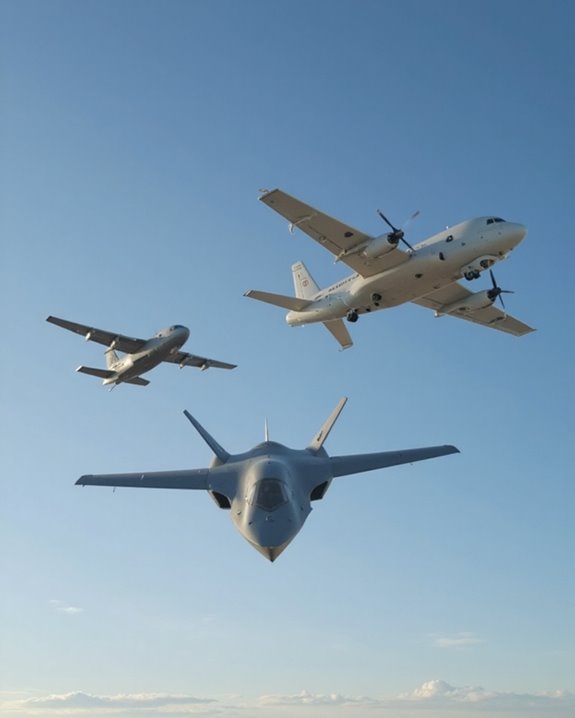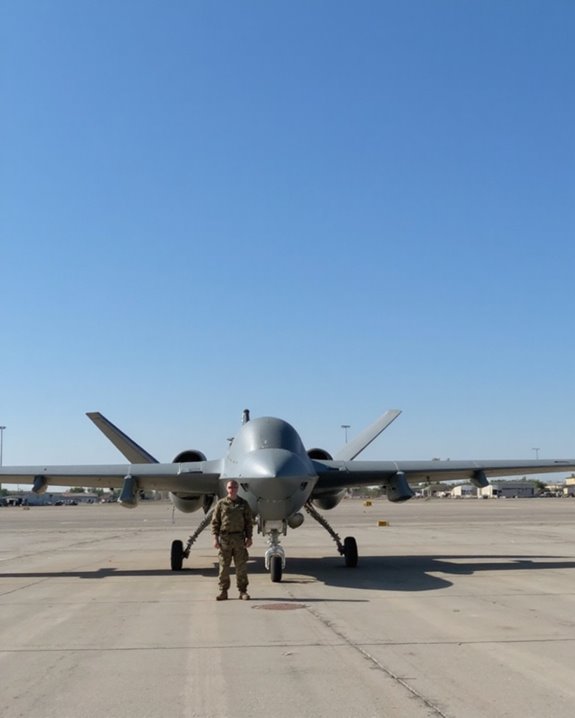Military drones have a wild history—starting with bomb-dropping balloons in 1849 Venice, awkward radio-controlled planes like the Queen Bee, and the crafty Kettering Bug in World War I (it didn’t exactly win awards for stability). By Vietnam, drones like the Lightning Bug flew secret spy missions, while today’s MQ-9 Reapers bring real-time video and scary precision. Now, drones use AI to spot enemies and even help stop wildfires! Stick around to see just how much innovation has taken off.
Key Takeaways
- Military drones began with 19th-century unmanned balloons and early 20th-century remote-controlled aircraft for reconnaissance and target practice.
- World Wars I and II featured experimental and mass-produced drones, advancing remote control and reconnaissance capabilities.
- Cold War and Vietnam War eras saw drones used for high-risk reconnaissance, decoy missions, and psychological operations without endangering pilots.
- Modern drones like the Predator and Reaper introduced real-time video, remote strike abilities, and higher levels of autonomy.
- Today, military drones employ AI for surveillance, strike missions, and disaster monitoring, raising ethical and legal debates over their use.
Early Experiments With Unmanned Aerial Vehicles
One of the most fascinating chapters in aviation history began with the very first experiments using unmanned aerial vehicles, or UAVs—yes, even before the word “drone” became cool! Imagine scientists and inventors testing civilian prototypes not for war, but for adventure and discovery. Scientific balloons like those flown by the Montgolfier brothers in 1782 lifted instruments high above Earth, inspiring dreams of unmanned flight. Balloons weren’t just for show—Gasper Felix Tournachon snapped the first aerial photo over Paris from one in 1858, sparking early reconnaissance ideas. By the early 1900s, tinkerers were strapping cameras to rockets, and the Curtiss N-9 seaplane was adapted for remote control. These playful, daring experiments paved the way for the drones we recognize today! The military-grade Raven UAV built on these early innovations with advanced sensor packages and battle-tested designs for reliable reconnaissance missions.
The First Military Applications in the 19th Century
As inventors tinkered with flying machines and scientists launched balloons skyward for science, military minds saw opportunity in the clouds—why not use unmanned balloons for war? In 1849, during the Austrian attack on Venice, hot-air balloons loaded with small bombs drifted above the city. These were the first military drones! Yet, Balloon Limitations quickly became clear. The wind, not any clever invention, chose where the balloons went, making their flight paths unpredictable and sometimes downright ridiculous. Strategic Risks were everywhere: payloads were tiny, and enemy soldiers could simply shoot down the balloons or watch them float away harmlessly. Still, this wild experiment showed that unmanned flight could change warfare. Although these balloons weren’t perfect, they planted seeds for future military innovations.
Pioneering Developments in the Early 20th Century
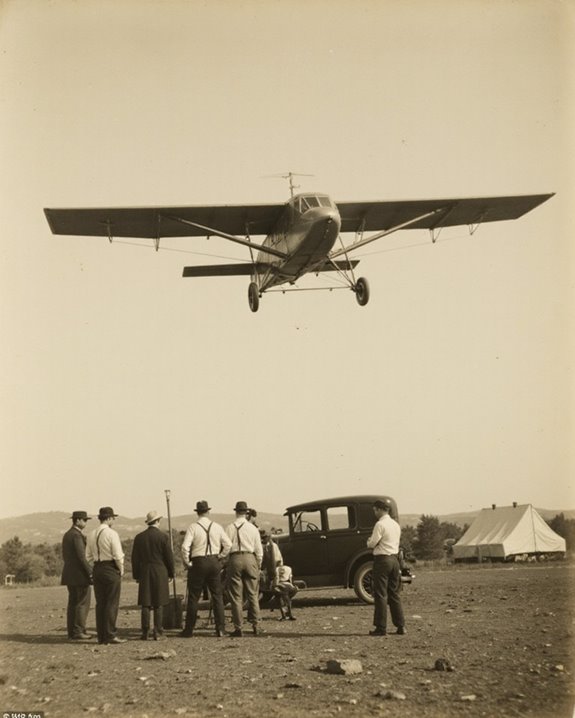
Step into the early 20th century—a time when inventors and military planners were not just dreaming up new gadgets, but actually turning wild science fiction into reality! The British de Havilland Queen Bee, a radio-controlled target drone made of spruce and plywood, showed everyone drones weren’t just toys or odd experiments anymore. It buzzed (pun intended) as a training tool, helping anti-aircraft gunners hit moving targets. Meanwhile, across the Atlantic, the U.S. Navy’s Project Fox wowed with television-guided assault drones, bringing remote-controlled attacks out of comic books and onto the seas. These early drones sparked ethical debates—should machines take on dangerous jobs, or might they one day replace humans entirely? Even civilian applications were hinted at, as practical uses beyond combat started to dawn.
Advancements During World War I
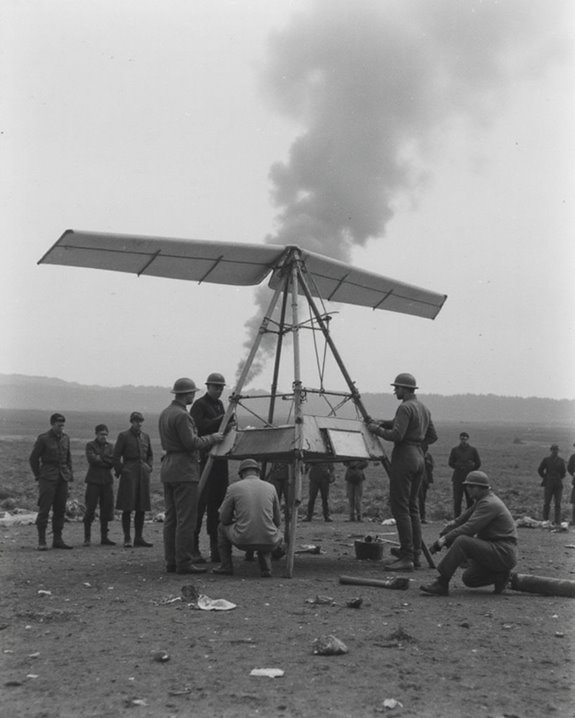
Curiosity fueled the race for innovation during World War I, and inventors leapt at the chance to experiment with pilotless aircraft—even if the technology was more “trial and error” than top secret. Early drones, like the American Kettering Bug, were basically flying torpedoes, but they faced big problems with drone stability. Imagine a model airplane wobbling in the wind—that’s what early engineers had to fix! Range limitations were another headache; these drones couldn’t fly very far before losing control or running out of fuel. British and German teams also dabbled in unmanned flight, but results were mostly experimental. Still, every shaky test flight built experience for future breakthroughs. Even though these early drones weren’t reliable, their inventors were already dreaming of bigger possibilities!
The Interwar Years and Technological Progress
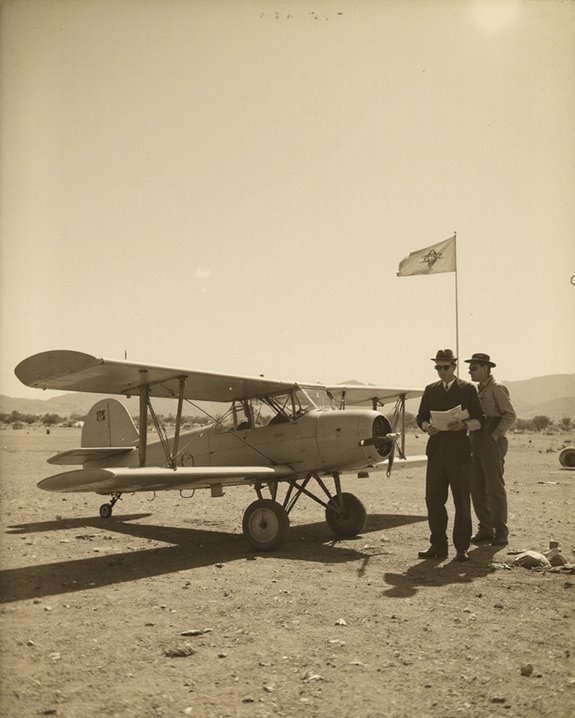
World War I’s shaky experiments with pilotless aircraft may have looked like science fair projects on steroids, but the years that followed brought real breakthroughs! During the interwar years, radio technology improved leaps and bounds, allowing drones like the UK’s Queen Bee to buzz through the skies as target practice for anti-aircraft gunners. These advancements weren’t just about fun and games—militaries saved money (think big Economic Implications) by training with drones instead of manned planes. Scientific Exchanges kicked into high gear, too, as countries like the U.S., Soviet Union, Germany, and the UK swapped ideas, designs, and sometimes a few secrets. New materials, stronger engines, and better navigation systems made drones more reliable, setting the stage for even more ambitious military uses in the future.
Roles of Drones in World War II

During the chaos of the 1940s, military drones took on roles that would have seemed straight out of a comic book just a few decades earlier. The U.S. mass-produced drones like the Radioplane OQ-2, sending over 15,000 into the skies—imagine tiny robot planes zipping around! Their main job? Target Practice. Pilots needed moving targets, not just painted bullseyes, so these drones became airborne bullseyes, helping crews sharpen their aim. But that’s not all—they were also used in Decoy Missions, tricking enemy forces by mimicking real aircraft. Some, like the TDN-1, even carried bombs, though their aim wasn’t always spot-on. All in all, these early drones proved essential, quietly shaping the battlefield while earning their place in military history.
Expanding Capabilities Post-World War II
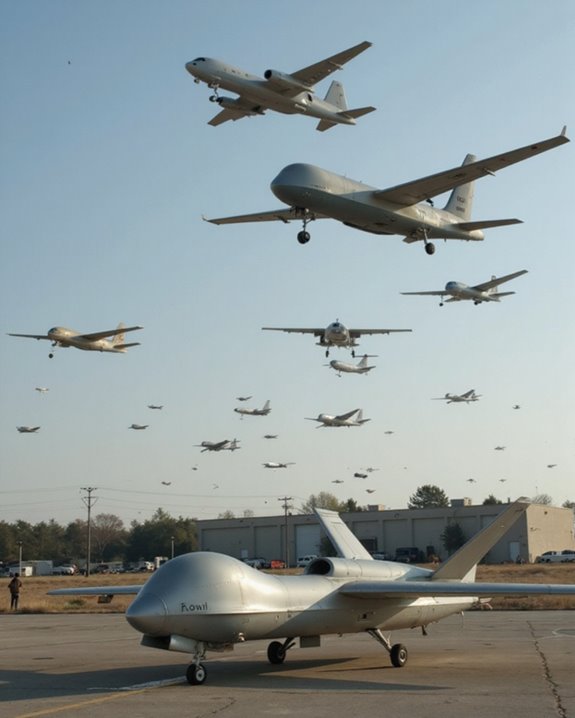
Although the chaos of World War II kickstarted drone innovation, what happened next was a total game-changer—military drones didn’t just stick to being flying targets anymore! After the war, drones started using clever Decoy Tactics, tricking enemy defenses and making pilots sweat a little. Suddenly, these machines were dropping leaflets for psychological ops, launching missiles at hardened targets, and even acting as remote-controlled flying bombs, adapted from old B-17s and B-24s. With new tech, drones soared higher and stayed aloft longer, thanks in part to early Solar Integration—no more worrying about running out of fuel mid-mission! Improvements in cameras and controls meant operators could guide drones from afar, opening the door to missions that were once thought impossible. Today, advanced models feature military-grade capabilities such as high-resolution cameras and extended flight times for complex tactical operations.
Breakthroughs and Deployment in the Vietnam Era
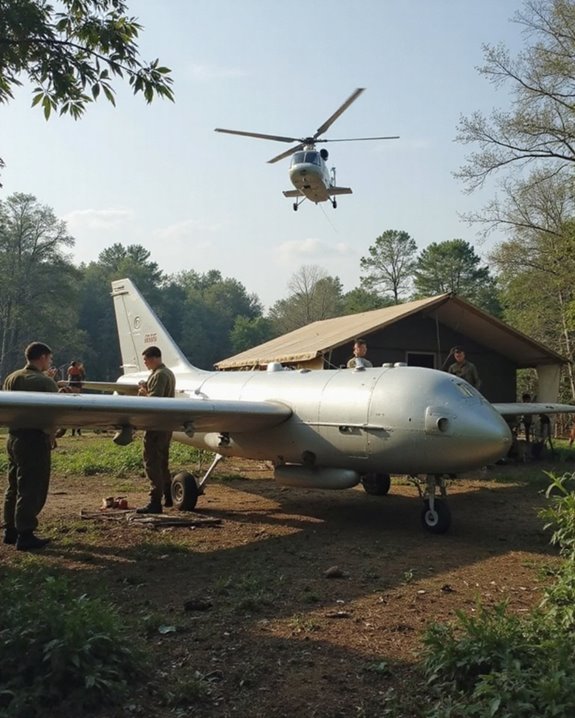
Suddenly, drones weren’t just science fiction gadgets—they became real MVPs in the Vietnam War! The Ryan Model 147 Lightning Bug soared into action, snapping photos and gathering secrets without risking pilots. These drones rode piggyback on C-130s, parachuting home near friendly bases—talk about a dramatic return! Besides spying, they fooled enemy defenses in Decoy Operations, dropped propaganda leaflets during Leaflet Drops, and sometimes even launched missiles at fixed targets. The drones’ missions—over 3,400 flights—were risky; some completed just a handful, while legends like “Tom Cat” nearly set records. Engineers kept pushing boundaries, adding better cameras, remote controls, and clever parachute recoveries. Driven by the need for safe intelligence after the U-2 crisis, Vietnam-era drones changed the rules of wartime technology forever.
The Rise of Modern Drone Programs
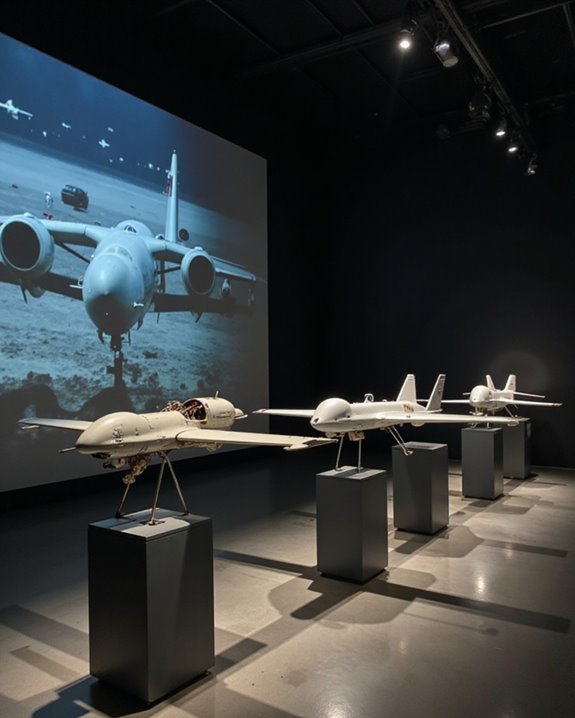
If you thought drones were impressive in the Vietnam era, wait until you see how they took off in the late 20th century! In the 1980s, the U.S., inspired by Israel’s jaw-dropping success against the Syrian Air Force, rapidly expanded its drone programs. The RQ-2 Pioneer, born from U.S.-Israeli collaboration, even made Iraqi soldiers surrender during the Gulf War—talk about intimidating! By the mid-1990s, the Predator drone arrived, offering real-time video and remote strikes, and the MQ-9 Reaper soon followed, packing even more power. As drones became force multipliers, questions about Ethical Implications and Legal Frameworks started buzzing louder. With improved sensors, longer flights, and higher autonomy, drones weren’t just eyes in the sky—they were changing the rules of engagement! Today, professional security increasingly relies on FAA-approved drone detection technologies to counter unauthorized drone threats.
Contemporary Uses and Ongoing Innovations
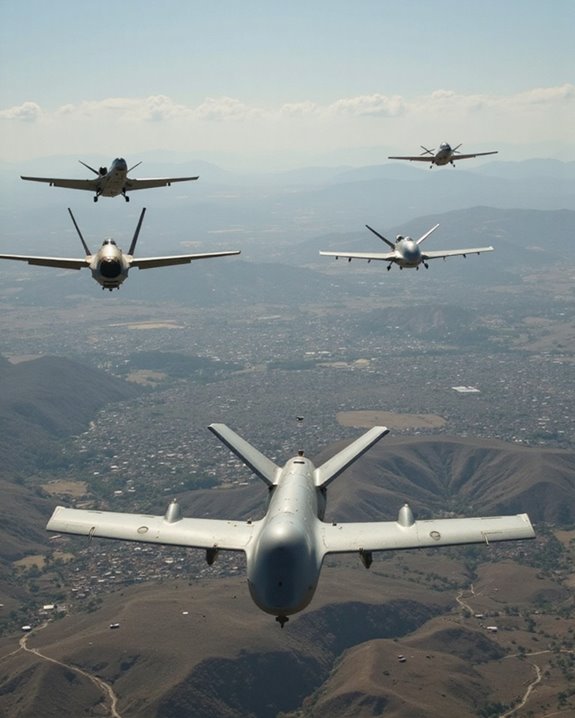
Innovation takes center stage in today’s world of military drones, and the results are nothing short of fascinating! Imagine drones zipping through the sky, equipped with AI applications that help them spot enemy movements, monitor disasters, or even deliver supplies—talk about multitasking machines! Surveillance and reconnaissance remain top priorities, but now, drones also fight fires, track pollution, and assist in disaster zones. Market trends point to massive growth, with global investments soaring and countries like the U.S. and India leading the charge. There’s even a push for disposable, low-cost models—think “throwaway tech” that’s actually useful! Enhanced cybersecurity and payloads mean drones are tougher and more versatile than ever. With all this progress, it’s clear: military drones aren’t just flying robots—they’re game changers!
Frequently Asked Questions
How Are Military Drone Operators Trained and Selected?
Nearly 90% of U.S. Air Force drone operators hold technical degrees, highlighting rigorous operator selection. Training simulations develop technical proficiency, ethical judgment, and mental resilience, while candidates must meet strict physical, security, and educational requirements before qualifying for specialized instruction.
What Are the Main Differences Between Military and Commercial Drones?
The main differences between military and commercial drones include armament features, higher endurance levels, secure communications, stealth capabilities, and advanced payloads in military drones, whereas commercial drones prioritize ease of use, lighter payloads, and shorter operational ranges.
How Do Countries Regulate the Export of Military Drone Technology?
Countries regulate the export of military drone technology through strict export regulations, licensing requirements, and adherence to international treaties such as the MTCR. These frameworks limit technology transfer, guarantee end-use monitoring, and align exports with foreign policy objectives.
What Counter-Drone Technologies Exist to Defend Against Hostile UAVS?
Counter-drone technologies include radar systems, integrated sensors, and layered defense approaches. Methods such as drone jamming, laser defense, electronic warfare, high-powered microwaves, and kinetic interceptors like missiles and netting systems are employed to neutralize hostile UAVs.
How Are Drones Maintained and Repaired During Active Military Operations?
Like a pit crew servicing a race car mid-competition, military teams deploy repair kits and diagnostic tools in the field, enabling rapid inspections, part replacements, and software updates to guarantee drones remain mission-ready despite operational challenges.

